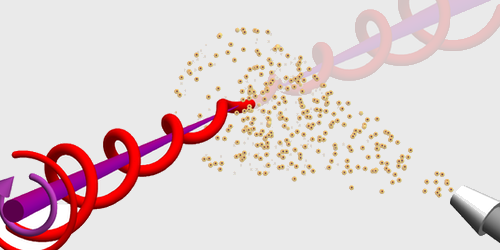Magnetizing an Atomic Gas with Light
Nanoscale manipulations of a material’s magnetic moment are tricky, as the charge currents used for this process are difficult to control at this small length scale. Now, Jonas Wätzel of the Martin-Luther-University Halle-Wittenberg in Germany and his colleagues report that they might have a solution to that problem [1]. The researchers predict that the magnetization of an atomic gas can be altered by high-power lasers with patterned wavefronts. They say that the method could find use in studying and manipulating the magnetic properties of active materials.
The team modeled the interaction of two lasers with a gas of helium atoms. One laser is an infrared (IR) “vortex” laser with orbital angular momentum and a lateral intensity profile that drops to zero at the beam’s center. The other laser is an extreme-ultraviolet (XUV) pulsed laser that co-propagates within the IR beam’s low-intensity region. When the lasers hit the gas, the XUV pulse excites the atoms’ valence electrons into a so-called Rydberg state. The IR vortex then transfers angular momentum to the electron charge density of this Rydberg state, causing it to rotate. This rotation creates a magnetic moment in the system that can last for several nanoseconds.
The researchers say that the direction, magnitude, and extent of this magnetization can be fully controlled by adjusting the properties of the IR vortex laser. While the team’s preliminary experiments show that magnetization of a gas can be photoinduced using their new method, they have yet to apply the method to magnetically active materials. They say that such experiments, while realizable with current setups, will be challenging, as the method requires the lasers to irradiate atoms simultaneously and their beams to be aligned with nanoscale precision.
–Katherine Wright
Katherine Wright is the Deputy Editor of Physics Magazine.
References
- J. Wätzel et al., “Light-induced magnetization at the nanoscale,” Phys. Rev. Lett. 128, 157205 (2022).




